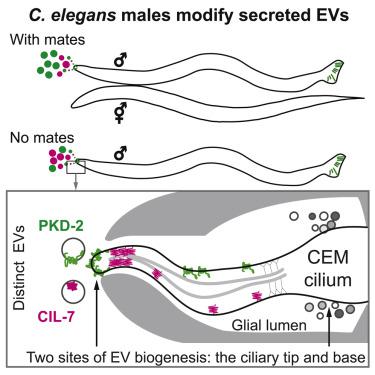Current Biology ( IF 8.1 ) Pub Date : 2021-07-15 , DOI: 10.1016/j.cub.2021.06.040 Juan Wang 1 , Inna A Nikonorova 1 , Malan Silva 2 , Jonathon D Walsh 1 , Peter E Tilton 1 , Amanda Gu 1 , Jyothi S Akella 1 , Maureen M Barr 1

|
Ciliary extracellular vesicle (EV) shedding is evolutionarily conserved. In Chlamydomonas and C. elegans, ciliary EVs act as signaling devices.1, 2, 3 In cultured mammalian cells, ciliary EVs regulate ciliary disposal but also receptor abundance and signaling, ciliary length, and ciliary membrane dynamics.4, 5, 6, 7 Mammalian cilia produce EVs from the tip and along the ciliary membrane.8,9 This study aimed to determine the functional significance of shedding at distinct locations and to explore ciliary EV biogenesis mechanisms. Using Airyscan super-resolution imaging in living C. elegans animals, we find that neuronal sensory cilia shed TRP polycystin-2 channel PKD-2::GFP-carrying EVs from two distinct sites: the ciliary tip and the ciliary base. Ciliary tip shedding requires distal ciliary enrichment of PKD-2 by the myristoylated coiled-coil protein CIL-7. Kinesin-3 KLP-6 and intraflagellar transport (IFT) kinesin-2 motors are also required for ciliary tip EV shedding. A big unanswered question in the EV field is how cells sort EV cargo. Here, we show that two EV cargoes— CIL-7 and PKD-2—localized and trafficked differently along cilia and were sorted to different environmentally released EVs. In response to mating partners, C. elegans males modulate EV cargo composition by increasing the ratio of PKD-2 to CIL-7 EVs. Overall, our study indicates that the cilium and its trafficking machinery act as a specialized venue for regulated EV biogenesis and signaling.
中文翻译:

感觉纤毛作为调节细胞外囊泡生物发生和信号传导的专门场所
睫状细胞外囊泡 (EV) 脱落在进化上是保守的。在衣藻和秀丽隐杆线虫中,纤毛 EV 充当信号装置。1、2、3 在培养的哺乳动物细胞中,纤毛 EV 调节纤毛处理,还调节受体丰度和信号传导、纤毛长度和纤毛膜动力学。4、5、6、 7 哺乳动物纤毛从尖端和沿睫状膜产生 EV。8 , 9本研究旨在确定不同位置脱落的功能意义,并探索纤毛 EV 生物发生机制。在活的秀丽隐杆线虫中使用 Airyscan 超分辨率成像动物,我们发现神经元感觉纤毛从两个不同的位置脱落 TRP 多囊蛋白 2 通道 PKD-2::GFP 的 EV:睫状体尖端和睫状体基部。纤毛尖端脱落需要通过肉豆蔻酰化的卷曲螺旋蛋白 CIL-7 富集 PKD-2 的远端纤毛。纤毛尖 EV 脱落也需要驱动蛋白 3 KLP-6 和鞭毛内运输 (IFT) 驱动蛋白 2 电机。电动汽车领域一个尚未解决的大问题是细胞如何对电动汽车货物进行分类。在这里,我们展示了两种 EV 货物——CIL-7 和 PKD-2——沿着纤毛以不同的方式定位和运输,并被分类到不同的环境释放的 EV 中。作为对交配伙伴的回应,秀丽隐杆线虫雄性通过增加 PKD-2 与 CIL-7 EV 的比率来调节 EV 货物组成。总体而言,我们的研究表明纤毛及其贩运机制是调节 EV 生物发生和信号传导的专门场所。











































 京公网安备 11010802027423号
京公网安备 11010802027423号